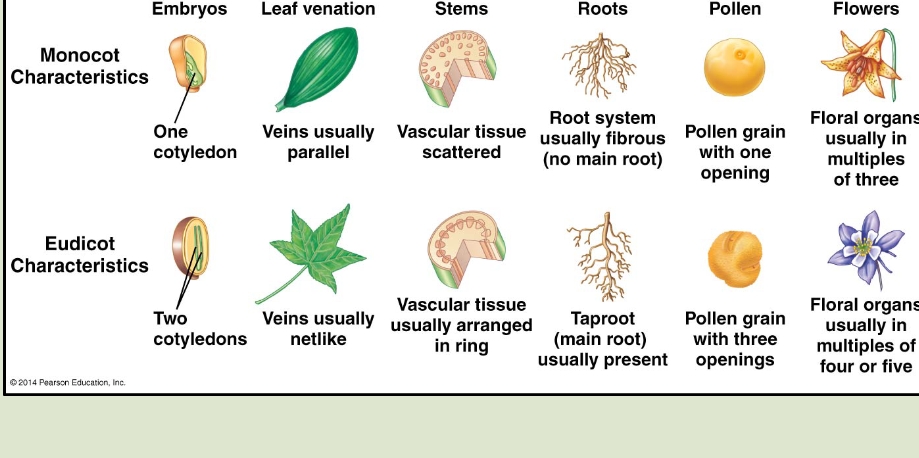Plant Diversity 2: The evolution of seed plants
1/12
There's no tags or description
Looks like no tags are added yet.
Name | Mastery | Learn | Test | Matching | Spaced |
|---|
No study sessions yet.
13 Terms
Colonization of Land
Three clades of land plants
1. Bryophytes (Non-Vascular Plants)
Examples: Mosses, Liverworts, Hornworts
Characteristics:
Lack vascular tissue (xylem and phloem) → depend on diffusion/osmosis for water transport
Require moist environments → sperm must swim to the egg for fertilization
Dominant gametophyte generation (haploid)
2. Seedless Vascular Plants
Examples: Ferns, Club Mosses, Horsetails
Characteristics:
Have vascular tissue (xylem & phloem) → can transport water & nutrients efficiently
Have true roots, stems, and leaves
Still require water for reproduction (flagellated sperm must swim to egg)
Dominant sporophyte generation (diploid)
3. Seed Plants (Gymnosperms & Angiosperms)
Examples: Conifers (Gymnosperms), Flowering plants (Angiosperms)
Characteristics:
Do not require water for reproduction → sperm is carried by pollen
Seeds protect and nourish the embryo
Angiosperms produce flowers & fruits for reproduction and dispersal
Dominant sporophyte generation (diploid)
Key Adaptation: Reduced Gametophyte: seed plants(angiosperms & gymnosperms)
Key Adaptation: Reduced Gametophyte
In seed plants, the gametophyte is microscopic and remains protected within the sporophyte. This adaptation increases survival and reproductive success.
Why It’s Important:
✅ Protection → Shields gametophytes from drying out and damage.
✅ Nutrient Supply → The sporophyte provides food and support.
✅ No Water Needed → Pollen delivers sperm directly to the ovule.
This adaptation helped seed plants dominate dry environments
Key Adaptation: Heterospory Seed plants (Gymnosperms & Angiosperms)
Heterospory is the production of two types of spores, which develop into separate male and female gametophytes. This adaptation improves reproductive efficiency and survival.
Two Types of Spores:
Microspores → Develop into male gametophytes (pollen) (sperm).
Megaspores → Develop into female gametophytes (inside ovules) (eggs).
Why Heterospory is Important:
✅ Increases Genetic Diversity → Separate male & female gametophytes encourage cross-fertilization.
✅ Protects Gametes → Female gametophyte stays inside the ovule for protection.
✅ No Water Needed → Pollen carries sperm directly to the egg.
🌱 Bryophytes (mosses, liverworts, hornworts)
✅ Homosporous
One kind of spore → grows into a gametophyte that makes both egg & sperm
🌿 Seedless Vascular Plants
Includes ferns, club mosses, horsetails
⚖ Most are homosporous, some are heterosporous
Example:
Ferns = homosporous
Some club mosses & water ferns = heterosporous
🌸 Seed Plants (gymnosperms & angiosperms)
✅ Always heterosporous
Produce:
Microspores → male gametophyte (inside pollen)
Megaspores → female gametophyte (inside ovule)

Key Adaptation: Ovules
An ovule is a structure in seed plants where the female gametophyte (megaspore) develops and fertilization occurs. It is retained within the parent sporophyte, providing protection and nutrients.
How It Works:
Megasporangium (inside ovule) produces a megaspore.
Megaspore develops into the female gametophyte, which remains inside the ovule.
Fertilization occurs when pollen delivers sperm to the egg.
The fertilized ovule develops into a seed.
Why Ovules Are Important:
✅ Protection → Gametophyte stays inside the sporophyte, safe from the environment.
✅ Nutrient Supply → The parent plant provides food for the developing gametophyte and embryo.
✅ Efficient Reproduction → Seeds form after fertilization, allowing plants to survive in dry conditions.
This adaptation is unique to seed plants (Gymnosperms & Angiosperms) and is key to their success on land!
Difference Between Gymnosperms and Angiosperms in Ovules
Gymnosperms:
Ovules are exposed on cones.
Seeds are naked (not enclosed in fruit).
Angiosperms:
Ovules are inside the ovary of flowers.
Seeds are protected by fruit after fertilization.
Key Adaptation: Pollen
Pollen grain is the male gametophyte enclosed within a protective pollen wall.
It carries sperm cells and allows for fertilization without needing water.
How It Works:
Pollination is the transfer of pollen from the male part (anther or cone) to the female ovule.
Pollen can be carried by wind, animals, or water to reach the ovule.
No water needed for fertilization—sperm is delivered directly to the egg via the pollen.
Key adaptations: Seeds
A seed contains the developing embryo (sporophyte), a food supply, and is surrounded by a protective coat. Inside the seed, the female gametophyte supports the embryo’s growth.
How It Works:
The embryo (sporophyte) is the young plant that will grow into a mature plant.
The female gametophyte provides nutrients to the embryo and is inside the ovule before fertilization.
The seed coat (from the integument) protects the embryo and gametophyte, allowing the seed to survive harsh conditions.
Why It’s Evolutionarily Advantageous:
✅ Protection → Shields the embryo and gametophyte from environmental stress.
✅ Nutrient Supply → The food supply (from the female gametophyte) supports the developing embryo.
✅ Dispersal → Seeds can travel, increasing the plant's chances of colonizing new areas.
✅ Dormancy → Seeds can remain dormant until the environment is suitable for growth.
By combining both the sporophyte (embryo) and gametophyte (female), the seed offers a complete and protected system for plant reproduction, especially in dry environments. 🌱
Gymnosperms
"Naked Seed": Gymnosperms produce seeds that are not enclosed in a fruit (hence "naked"), unlike angiosperms which enclose their seeds in a fruit.
Conifers (A Type of Gymnosperm)
Conifers are gymnosperms that produce cones to hold their reproductive structures (male and female cones).
Examples: Pines, spruces, firs, cedars.
Other Gymnosperms
Not all gymnosperms produce cones.
Gymnosperm Life Cycle
Gymnosperm Life Cycle
✅ Sporophyte is dominant (large, visible, and produces cones).
✅ Gametophyte is tiny and dependent on the sporophyte (male in pollen, female in ovule).
✅ Pollination by wind → Pollen tube delivers sperm (no water needed).
✅ Fertilization inside ovule → Forms a seed with an embryo.
✅ Seeds disperse by wind or animals, starting a new cycle.
This allows gymnosperms to thrive in dry environments!
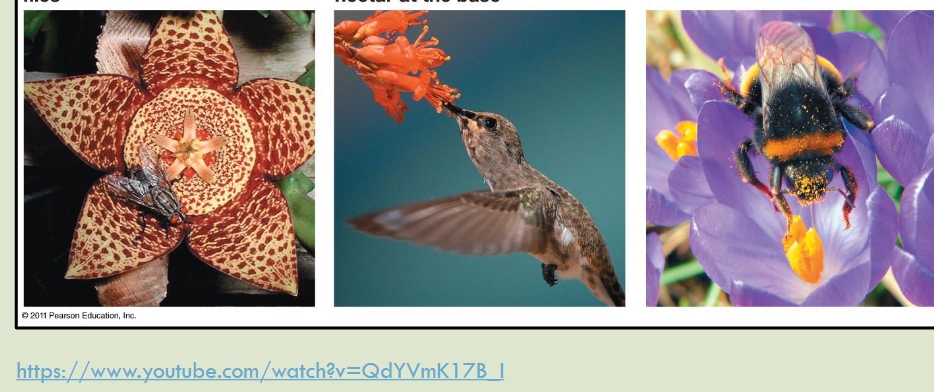
Key adaptations; Flowers
Key Adaptation: Flowers 🌸
A flower is a specialized shoot with up to four floral organs:
Sepals – Protect the bud before it opens.
Petals – Attract pollinators.
Stamens – Produce pollen (male reproductive organ).
Carpels – Contain the ovary with ovules (female reproductive organ).
Why Flowers Are Important:
✅ Pollination Efficiency – Attracts animals for targeted pollen transfer.
✅ Increases Genetic Diversity – Cross-pollination enhances variation.
✅ Leads to Fruit Formation – Protects and disperses seeds.
Flowers are a major reason angiosperm dominate plant life on Earth! 🌿🌸
Flowers enable directed pollination, meaning pollen is transferred efficiently by wind, insects, birds, or other animals, instead of relying solely on chance (like gymnosperms do with wind).
Why This is Important:
✅ Increases Pollination Success – More efficient than random wind dispersal.
✅ Encourages Cross-Pollination – Leads to greater genetic diversity.
✅ Supports Plant-Animal Relationships – Many flowers evolve to attract specific pollinators.
This adaptation gives angiosperms an advantage, helping them dominate Earth's ecosystems!
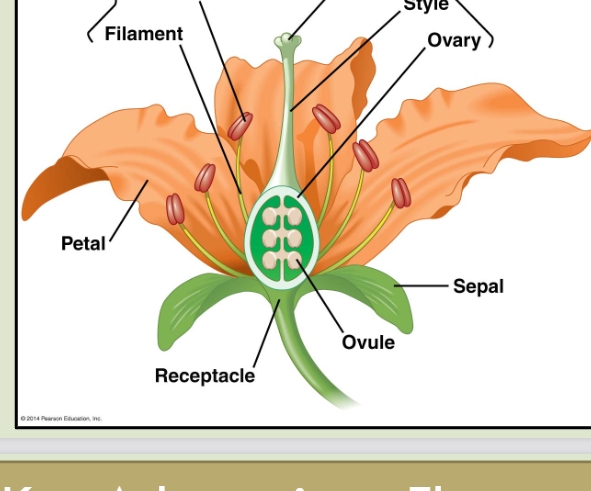
Key adaptations: Fruits
A fruit forms from the ovary after fertilization, protecting the seeds and aiding in dispersal.
Why Fruits Are Important:
✅ Protects Seeds – Shields them from damage and drying out.
✅ Aids Dispersal – Fruits attract animals, float on water, or get carried by wind.
✅ Increases Survival – Helps seeds spread to new locations for growth.
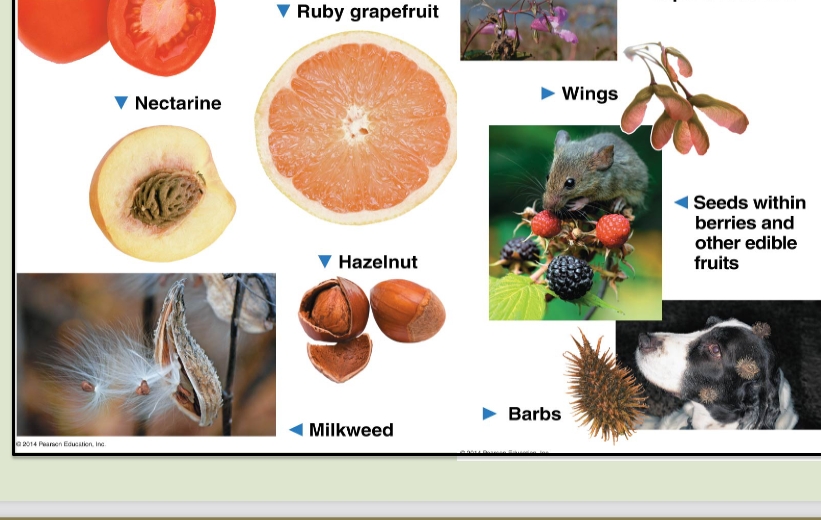
Angiosperm Life cycle
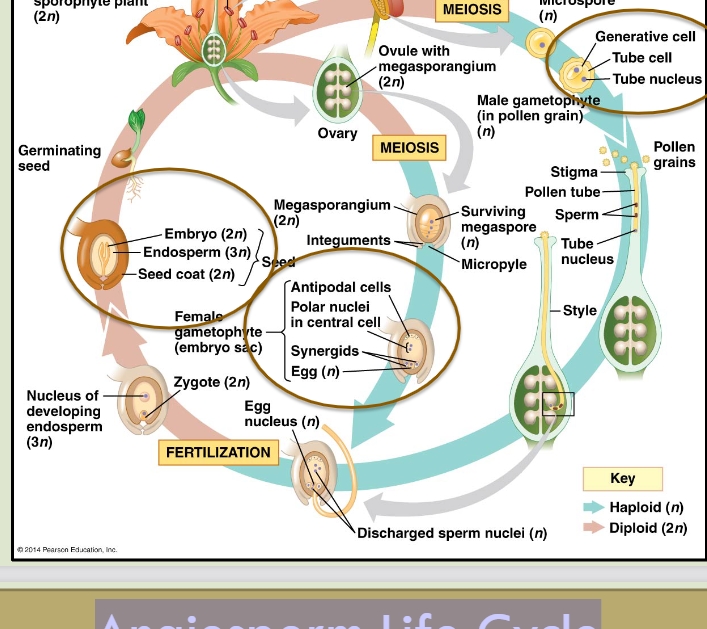
Angiosperm life cycle
Fertilization in angiosperms (flowering plants) involves double fertilization, which includes two sperm cells and the formation of the endosperm. Here’s how it works:
Two sperm cells are involved:
One sperm cell fertilizes the egg, forming the zygote (which develops into the embryo).
The second sperm cell fertilizes the central cell (which has two nuclei), forming the triploid (3n) endosperm, which provides nutrients for the developing embryo.
Endosperm formation:
The endosperm (3n) is a nutrient-rich tissue that supports embryo growth. This is unique to angiosperms.
This process is called double fertilization because two fertilization events occur: one forming the embryo and the other forming the endosperm.
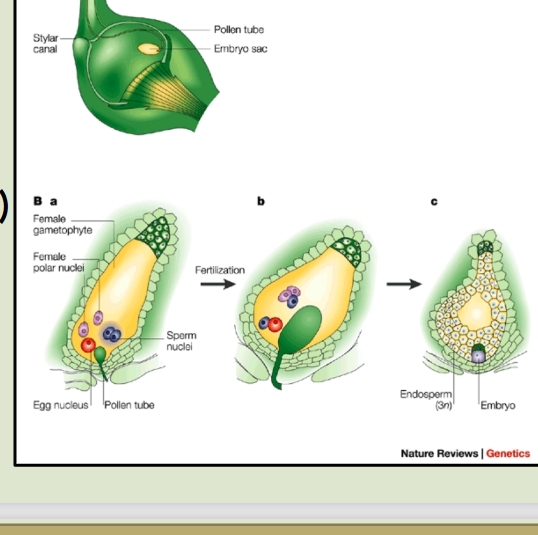
Angiosperms
